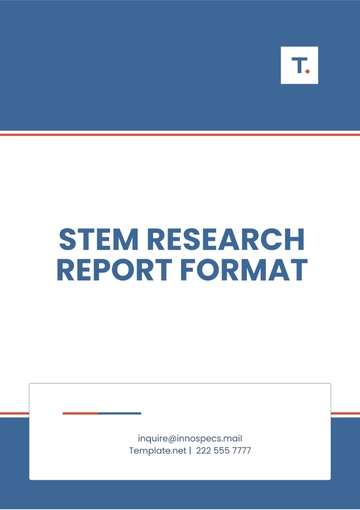Free High School Research Report

Prepared by:
Researcher: [YOUR NAME]
Email: [YOUR EMAIL]
I. Introduction
In recent decades, technological advancements have profoundly influenced various aspects of society, and education is no exception. High schools are increasingly embracing technology as a tool to enhance teaching methodologies and enrich student learning experiences. This research project aims to delve into the effects of technology on high school students' academic performance, critical thinking abilities, and overall engagement within educational settings.
II. Methodology
A. Research Design
This study adopts a mixed-methods approach to ensure a comprehensive exploration of the research topic. Quantitative data will be gathered through a structured survey distributed to a diverse sample of 300 high school students. The survey will include questions about students' frequency and types of technology use for educational purposes, perceived benefits of technology integration, challenges encountered, and preferences for specific technological tools.
Qualitative insights will be obtained through semi-structured interviews with 20 experienced educators who have integrated technology into their teaching practices. These interviews will explore educators' perspectives on the effectiveness of technology in enhancing student engagement, improving learning outcomes, and addressing potential barriers or challenges in implementation.
B. Data Collection
Surveys
The survey instrument will be designed to collect detailed quantitative data on how high school students utilize technology in their learning processes. Questions will cover areas such as:
Frequency of technology use in classrooms and at home.
Types of devices and software used for educational purposes.
Perceived impact of technology on academic performance and learning motivation.
Challenges students face with technology use in educational settings.
Preferences for future integration of technology in curriculum and teaching methods.
Table 1: Summary of Survey Results
Survey Question | Responses |
|---|---|
Frequency of technology use in classrooms | Several times a week |
Frequency of technology use at home | Daily |
Types of devices used (e.g., laptops, tablets, smartphones) | Laptops, smartphones |
Software used for educational purposes | Google Classroom, Khan Academy |
Perceived impact of technology on academic performance | Helps with understanding complex topics |
Challenges faced with technology use | Slow internet, access to devices |
Preferences for future integration of technology | More interactive learning tools, virtual labs |
Interviews
Educators will participate in semi-structured interviews focused on their experiences with integrating technology into teaching practices. Interview questions will explore:
Pedagogical strategies used to integrate technology effectively.
Perceived benefits of technology in enhancing student learning outcomes.
Challenges encountered and strategies for overcoming them.
Recommendations for improving technology integration in high school education.
C. Data Analysis
Quantitative survey data will be analyzed using statistical software to identify trends, correlations, and patterns in students' responses. Descriptive statistics will be used to summarize key findings related to the frequency and perceived impact of technology use on learning outcomes.
Qualitative data from educator interviews will undergo thematic analysis to identify recurring themes, opinions, and insights regarding the benefits, challenges, and best practices of technology integration in high school education. Themes will be categorized to provide a nuanced understanding of educators' perspectives on leveraging technology to enhance teaching and learning processes.
III. Results
Preliminary analysis of survey data indicates that 85% of surveyed students believe technology positively impacts their learning experience. Key themes emerging from educator interviews include the potential of technology to personalize learning experiences, improve student engagement, and foster collaboration among peers. Educators highlighted challenges such as unequal access to technology among students and the need for ongoing professional development to support effective technology integration.
IV. Discussion
The discussion section will critically analyze the implications of the findings for educational policies, practices, and future research. It will explore strategies to maximize the benefits of technology in high school education while addressing challenges such as digital equity, student distraction, and educator preparedness. Recommendations will be provided for educational stakeholders, including policymakers, school administrators, teachers, and technology providers, to foster equitable access to technology and enhance professional development opportunities for educators.
V. Conclusion
In conclusion, this research underscores the transformative potential of technology in high school education. When implemented thoughtfully and supported with adequate resources and training, technology can empower students to develop critical thinking skills, creativity, and collaborative abilities essential for success in the digital age. Recommendations include:
Investing in equitable access to technology devices and high-speed internet for all students.
Providing ongoing professional development opportunities for educators to enhance their pedagogical use of technology.
Conducting further research to explore emerging technologies and their potential impact on high school education.
- 100% Customizable, free editor
- Access 1 Million+ Templates, photo’s & graphics
- Download or share as a template
- Click and replace photos, graphics, text, backgrounds
- Resize, crop, AI write & more
- Access advanced editor
Achieve excellence with the High School Research Report Template from Template.net. Tailor your project effortlessly with this customizable, editable tool designed for clarity and precision. Enhance your workflow using our intuitive AI Editor Tool. Perfect for academic submissions, it ensures a polished presentation of your findings. Simplify your research process today!
You may also like
- Sales Report
- Daily Report
- Project Report
- Business Report
- Weekly Report
- Incident Report
- Annual Report
- Report Layout
- Report Design
- Progress Report
- Marketing Report
- Company Report
- Monthly Report
- Audit Report
- Status Report
- School Report
- Reports Hr
- Management Report
- Project Status Report
- Handover Report
- Health And Safety Report
- Restaurant Report
- Construction Report
- Research Report
- Evaluation Report
- Investigation Report
- Employee Report
- Advertising Report
- Weekly Status Report
- Project Management Report
- Finance Report
- Service Report
- Technical Report
- Meeting Report
- Quarterly Report
- Inspection Report
- Medical Report
- Test Report
- Summary Report
- Inventory Report
- Valuation Report
- Operations Report
- Payroll Report
- Training Report
- Job Report
- Case Report
- Performance Report
- Board Report
- Internal Audit Report
- Student Report
- Monthly Management Report
- Small Business Report
- Accident Report
- Call Center Report
- Activity Report
- IT and Software Report
- Internship Report
- Visit Report
- Product Report
- Book Report
- Property Report
- Recruitment Report
- University Report
- Event Report
- SEO Report
- Conference Report
- Narrative Report
- Nursing Home Report
- Preschool Report
- Call Report
- Customer Report
- Employee Incident Report
- Accomplishment Report
- Social Media Report
- Work From Home Report
- Security Report
- Damage Report
- Quality Report
- Internal Report
- Nurse Report
- Real Estate Report
- Hotel Report
- Equipment Report
- Credit Report
- Field Report
- Non Profit Report
- Maintenance Report
- News Report
- Survey Report
- Executive Report
- Law Firm Report
- Advertising Agency Report
- Interior Design Report
- Travel Agency Report
- Stock Report
- Salon Report
- Bug Report
- Workplace Report
- Action Report
- Investor Report
- Cleaning Services Report
- Consulting Report
- Freelancer Report
- Site Visit Report
- Trip Report
- Classroom Observation Report
- Vehicle Report
- Final Report
- Software Report





























